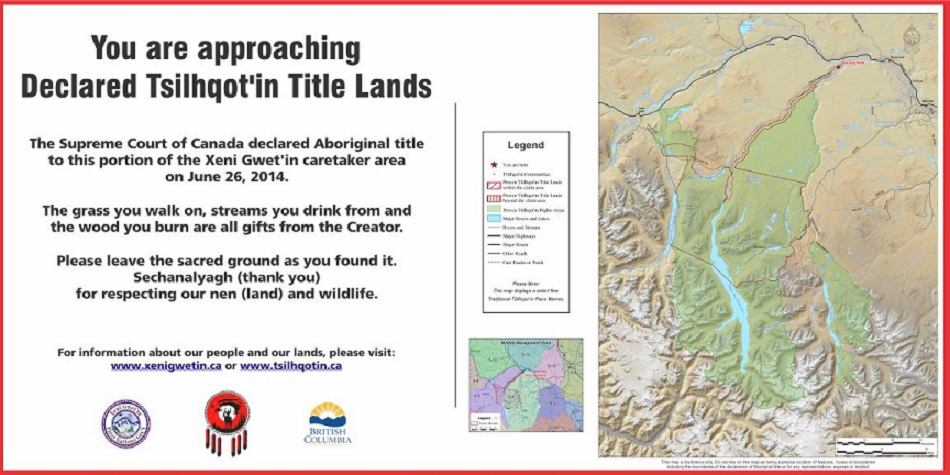Featured image: Tsilhqot’in Nation community highway signs unveiled in 2015 as Supreme Court decision was being implemented. “Members of the public traveling into Nemiah Valley or Tatlayoko Valley can expect to see signs in the vicinity advising them when they are approaching declared Tsilhqot’in Title Lands,” shared the Government of the Province of British Colombia, on Flickr July 30, 2015.
As wildfires are raging across four out of six Tsilhqot’in First Nation communities in Canada, the British Colombia provincial government has quietly authorized drilling permits to Taseko Mines Ltd, mining company who has made multiple failed attempts to launch a gold and copper mine on Tsilhqot’in territory.
For two decades, the company has aggressively pushed plans to construct an open-pit mine capable of producing 70,000 tons of ore per day over 20 years. It has twice been rejected by the federal government, in 2010 and 2014, after strong organizing by the Tsilhqot’in Nation and numerous concerns voiced by independent panels and provincial and federal experts regarding environmental and cultural impacts. The proposed project is within a proven Tsilhqot’in Rights area and adjacent to the declared Tsilhqot’in Title Lands. The Tsilhqot’in are the only First Nation in Canada that have proven title to their lands in the courts, after winning a decades-long Supreme Court battle in 2014 which ruled that any economic development on land where title is established must have the consent of the First Nation.
Yet, the BC Ministry of Energy and Mines has issued permits to allow Taseko Mines Ltd. to conduct extensive pre-construction exploration for the New Prosperity mine proposal. The Tsilhqot’in are now forced to initiate another legal battle while simultaneously fighting disastrous wildfires leading to evacuations.
In a press release shared yesterday, July 17th, the Tsilhqot’in National Government announced:
“The Tsilhqot’in Nation will challenge the B.C. permits in court. The permits authorize 76 km of new or modified trails, 122 drill holes, 367 test pits dug by an excavator, and 20 km of seismic lines near Teztan Biny and Nabas – an area of profound cultural and spiritual importance that the Tsilhqot’in successfully fought to protect against two mine proposals.”
Chief Roger William, Chief of the Xeni Gwet’in First Nation and Vice-Chair of the Tsilhqot’in National Government shared his disbelief at “We are in shock. In the midst of B.C.’s worst crisis in decades, while our elders and children are threatened by wildfire, BC decides to add insult to injury by granting these permits. BC disregarded the immense record showing the importance of this area for our culture and approved extensive ground disturbance for a mine that cannot lawfully be built. Our people are understandably angry and cannot believe that BC would approve more destruction in an area of such spiritual and cultural importance for us. Especially when we are experiencing a state of emergency. We thought that we were in a new era, a post-Tsilhqot’in decision era. These permits call into question BC’s commitment to Indigenous peoples. It is an insult to the Tsilhqot’in people and to this new era of truth and reconciliation.”

